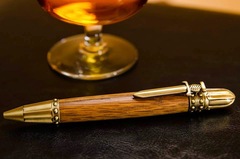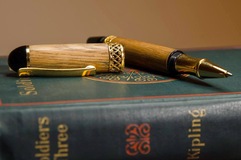
A ballpoint pen dispenses viscous oil-based ink by rolling a small hard sphere, usually 0.7-1.2 mm and made of brass, steel or tungsten carbide. The ink dries almost immediately on contact with paper. The ballpoint pen is usually reliable and inexpensive. It has replaced the fountain pen as the most common tool for everyday writing.

A rollerball pen dispenses a water-based liquid or gel ink through a ball tip similar to that of a ballpoint pen. The less-viscous ink is more easily absorbed by paper than oil-based ink, and the pen moves more easily across a writing surface. The rollerball pen was initially designed to combine the convenience of a ballpoint pen with the smooth "wet ink" effect of a fountain pen. Gel inks are available in a range of colors, including metallic paint colors and glitter effects.

A fountain pen uses water-based liquid ink delivered through a nib. The ink flows from a reservoir through a "feed" to the nib, then through the nib, due to capillary action and gravity. The nib has no moving parts and delivers ink through a thin slit to the writing surface. A fountain pen reservoir can be refillable or disposable, this disposable type being an ink cartridge. A pen with a refillable reservoir may have a mechanism, such as a piston, to draw ink from a bottle through the nib, or it may require refilling with an eyedropper. Refill reservoirs, also known as cartridge converters, are available for some pens to use disposable cartridges.